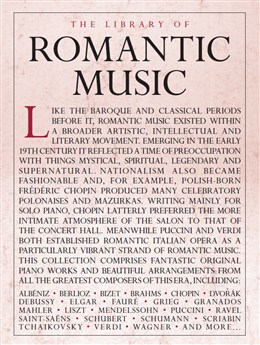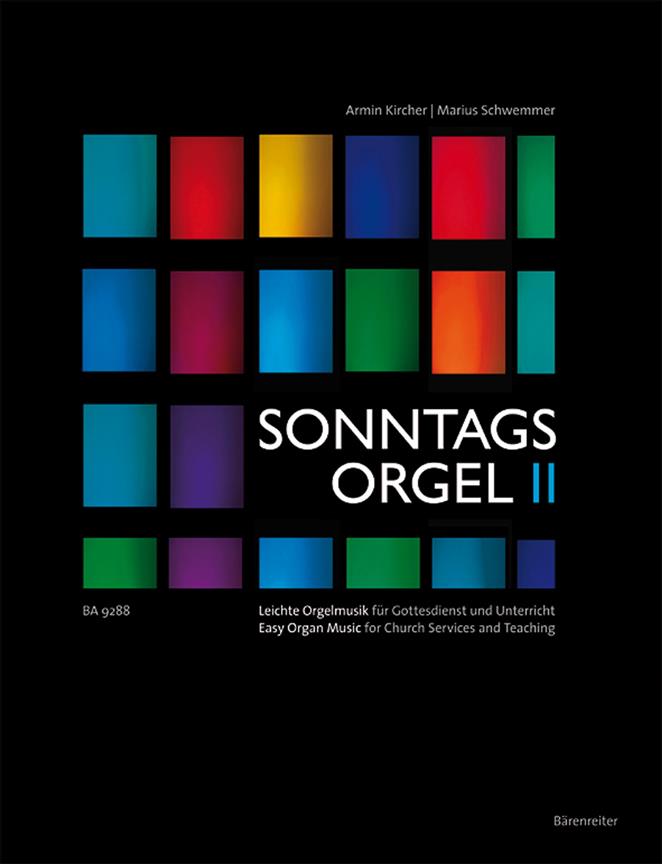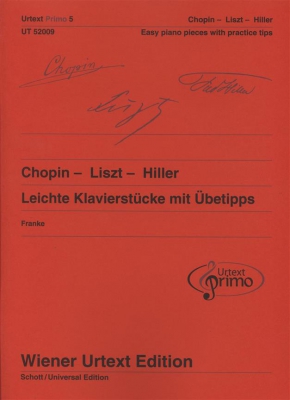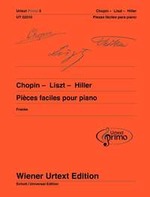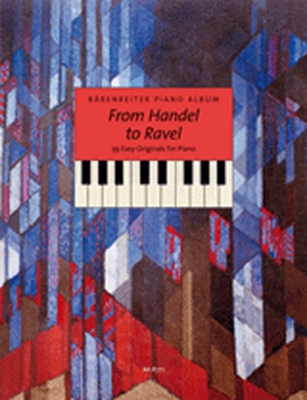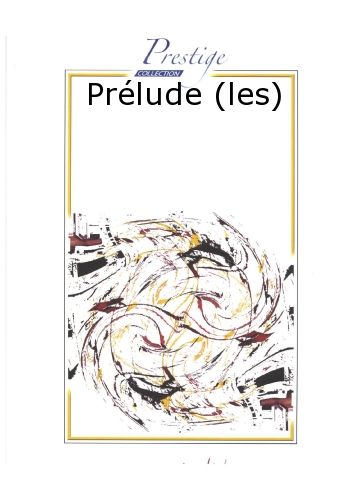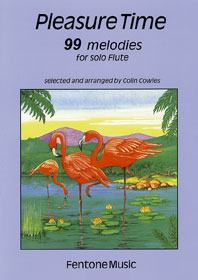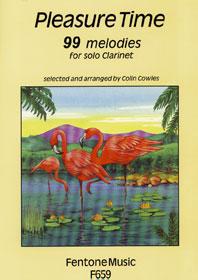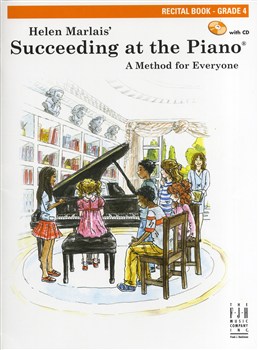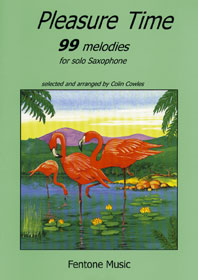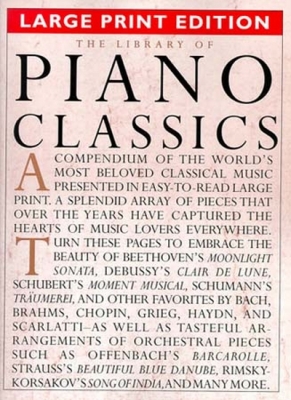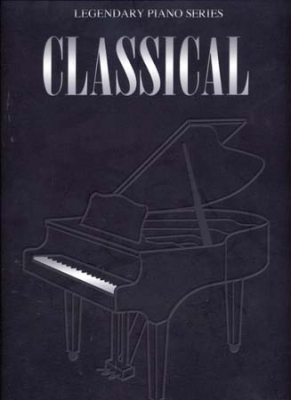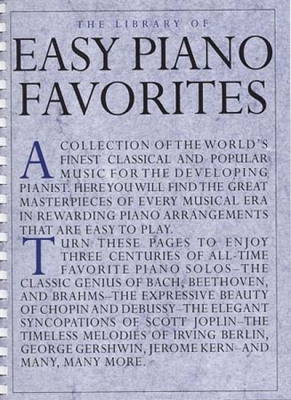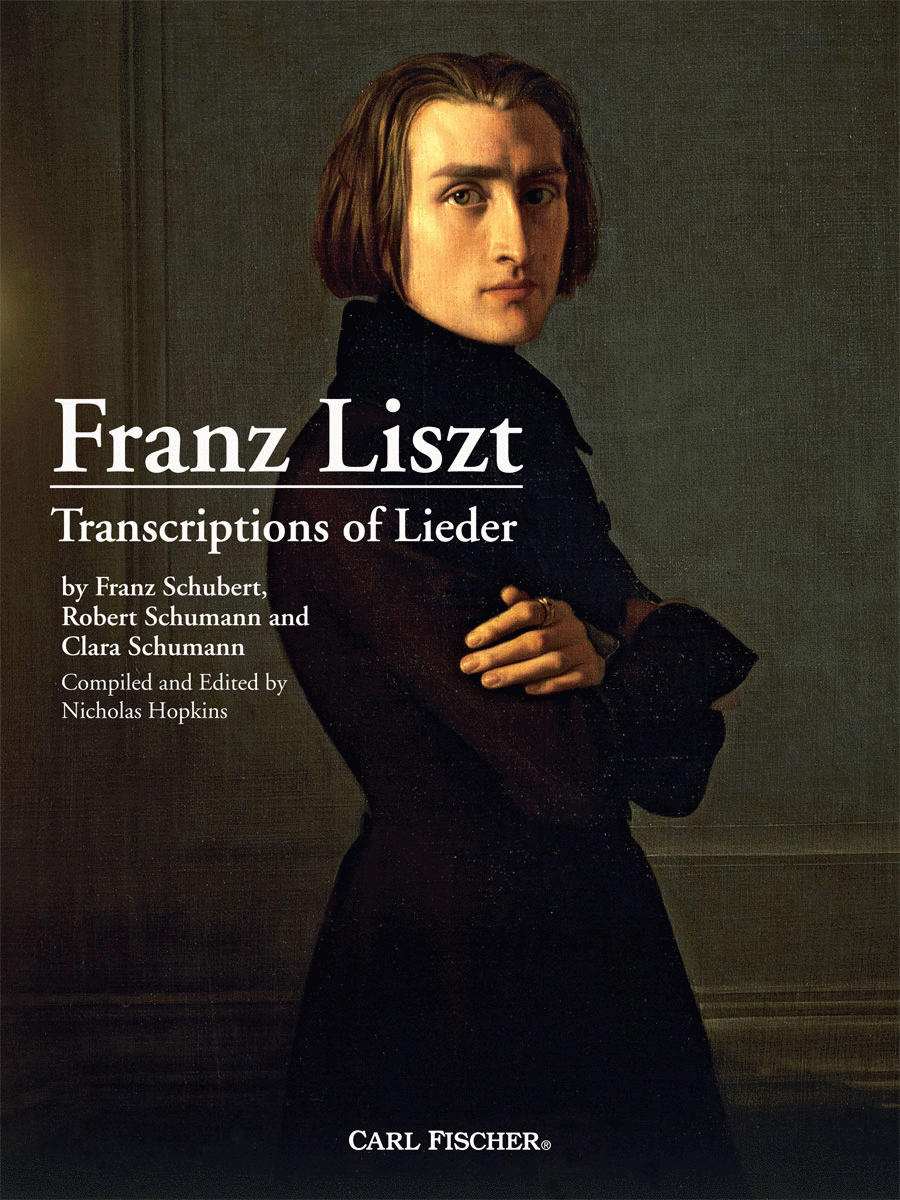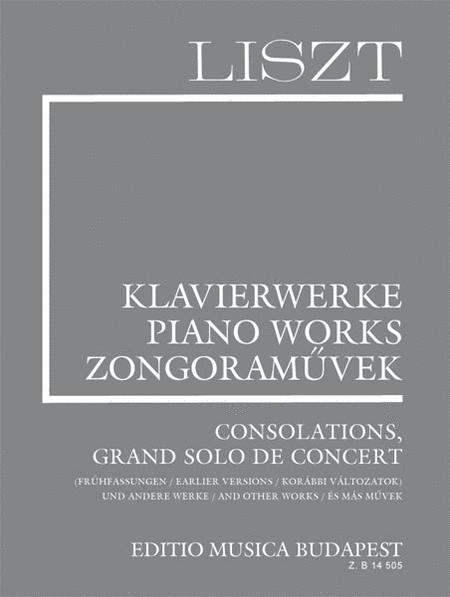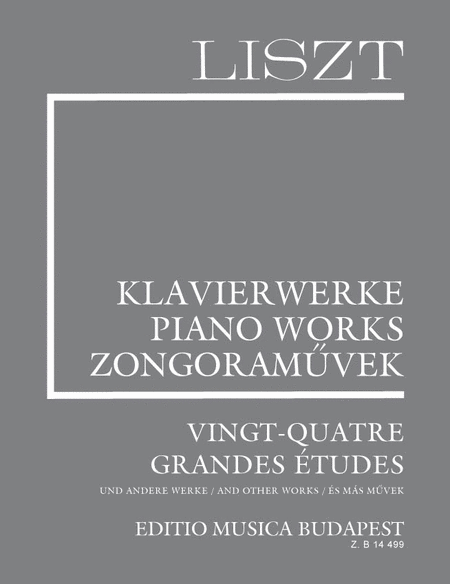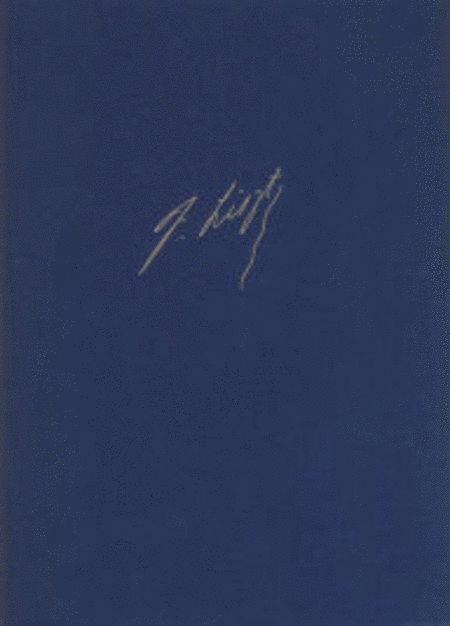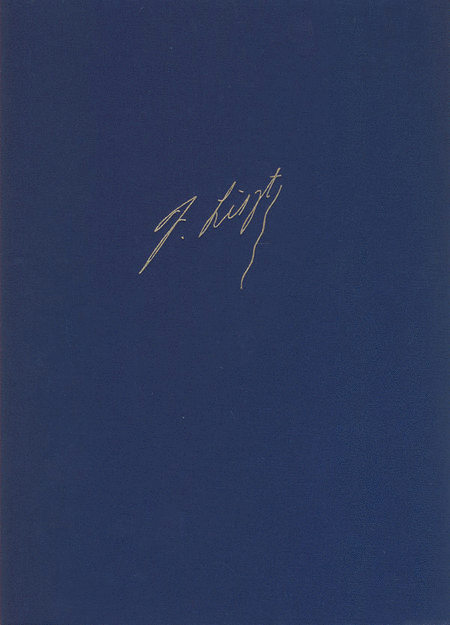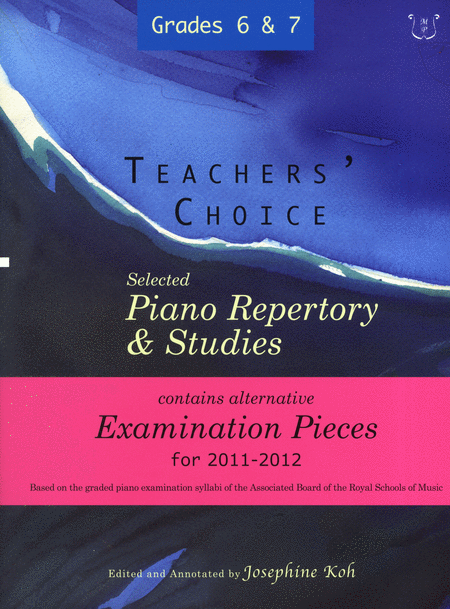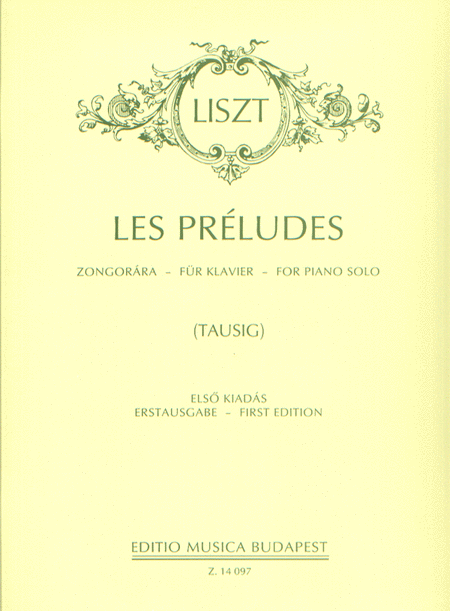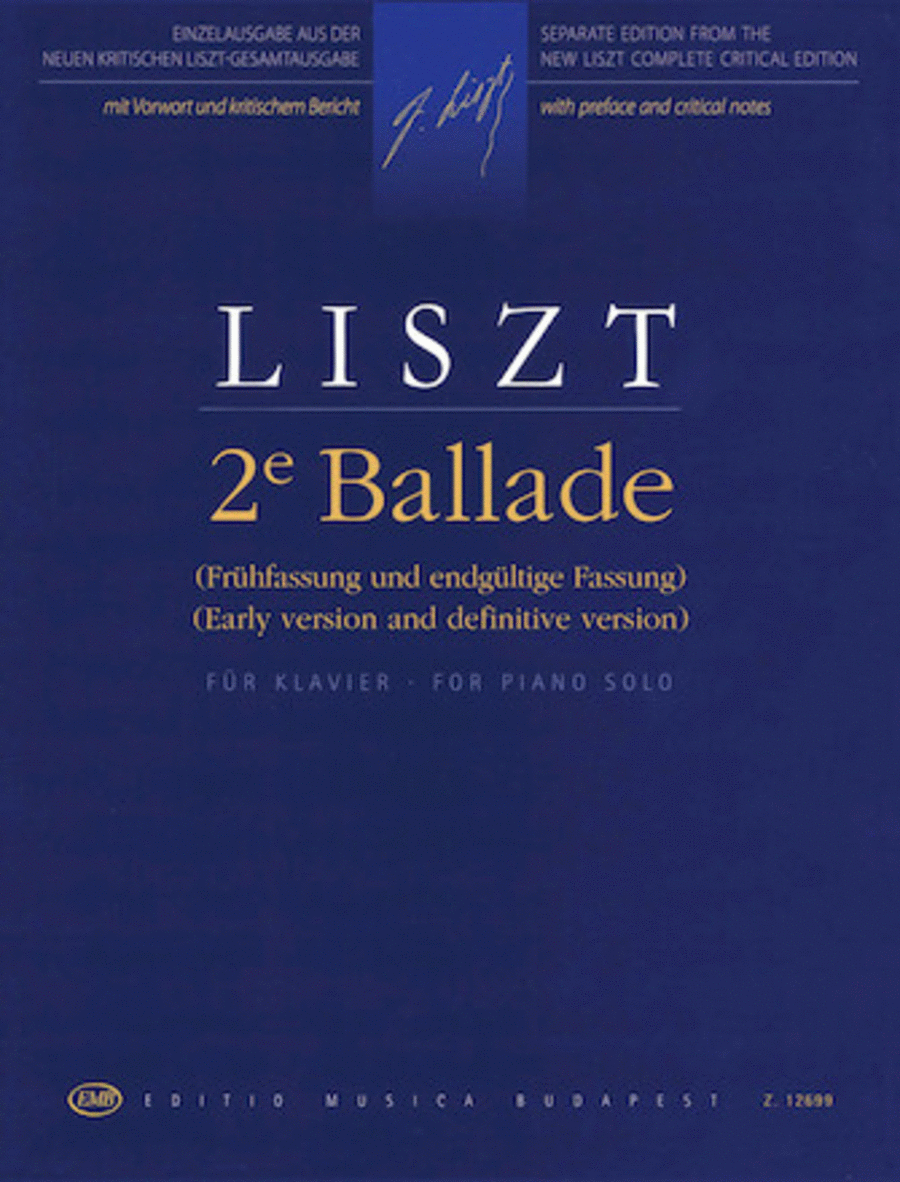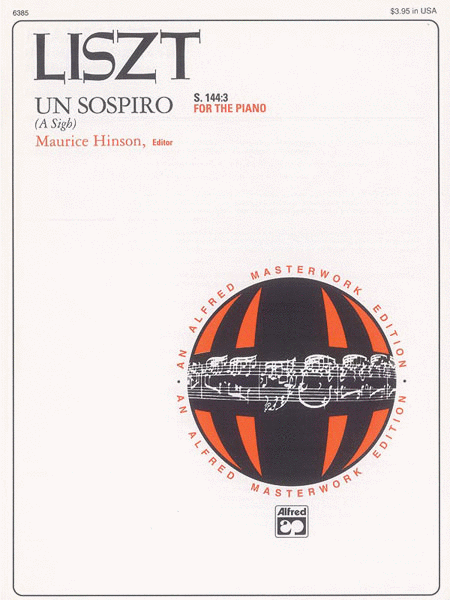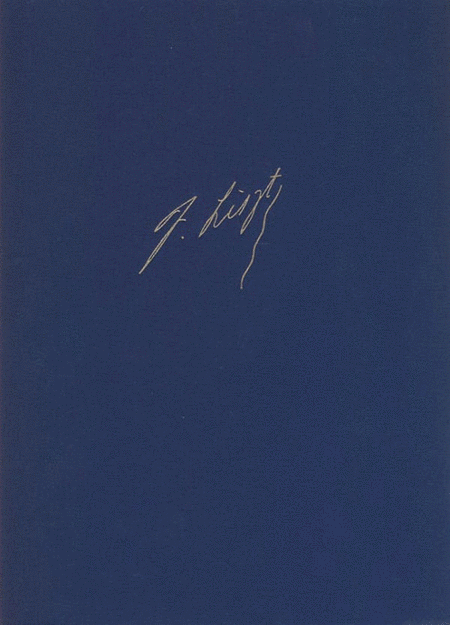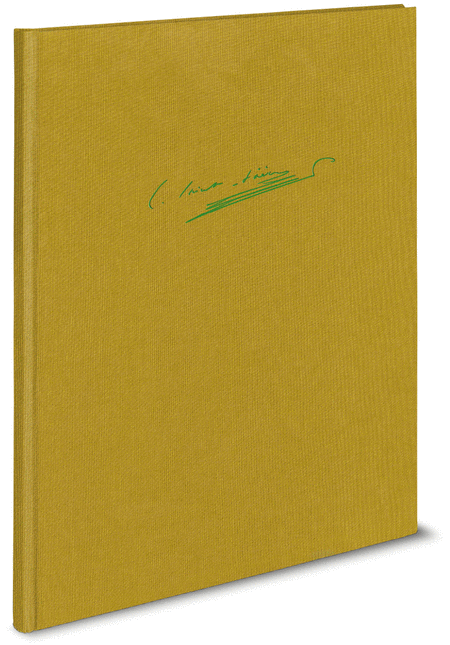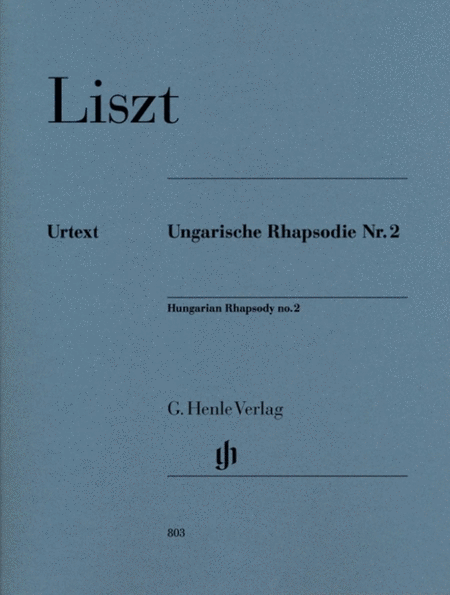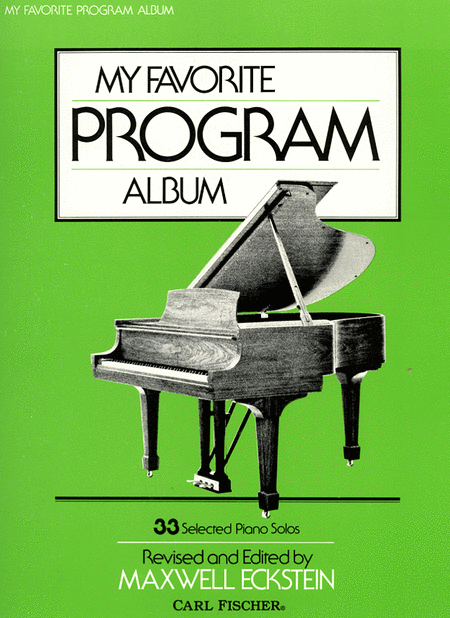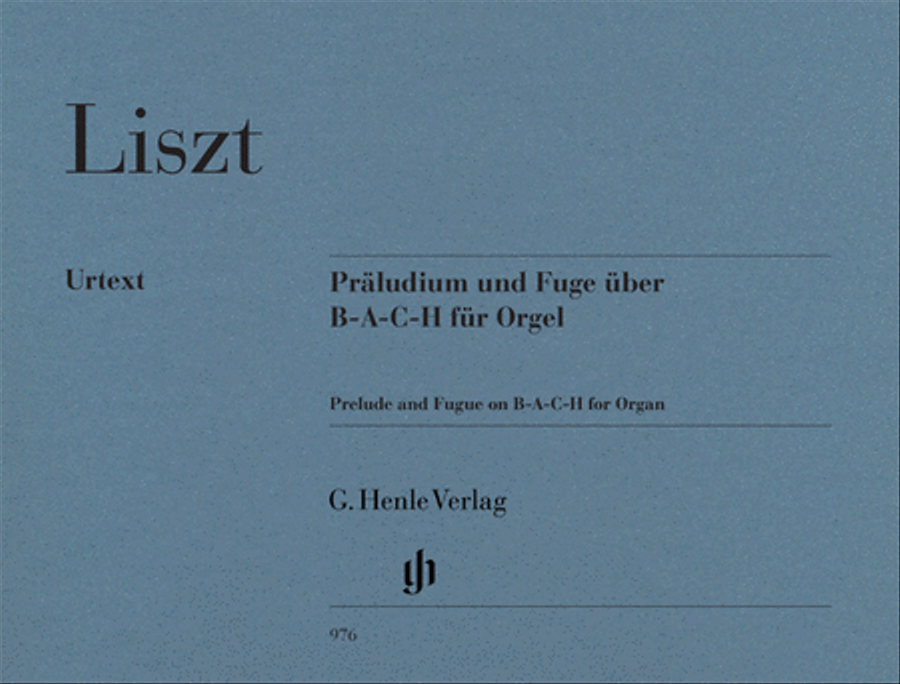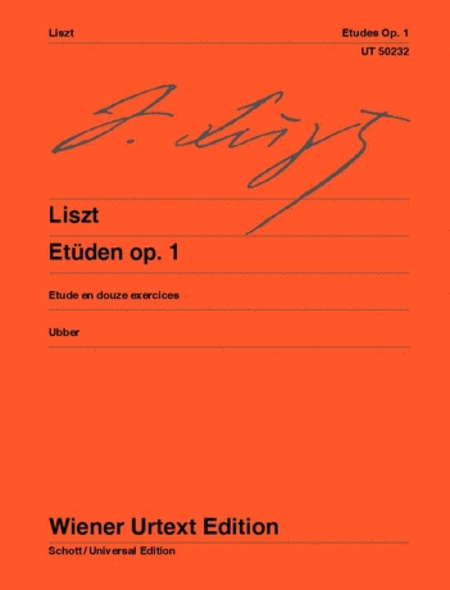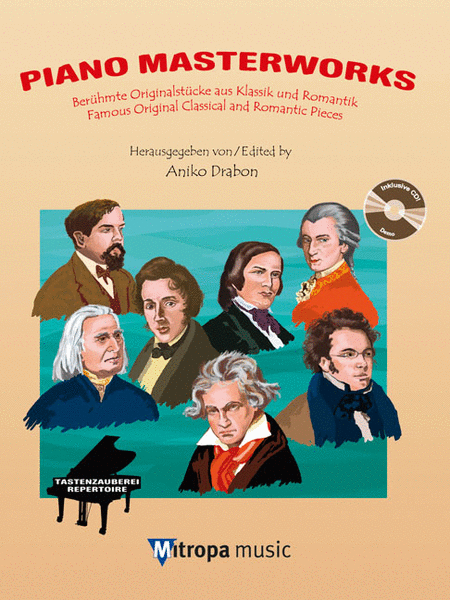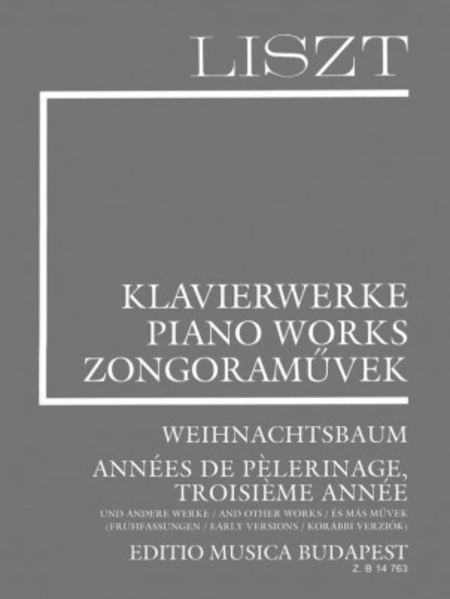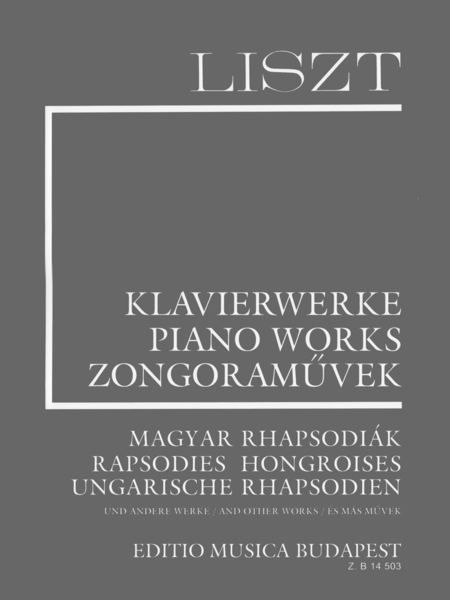|
| The Library Of Romantic
Music
Piano seul [Partition] - Intermédiaire/avancé
Amsco Wise Publications
The Library Of Romantic Music is a comprehensive collection of the greatest work...(+)
The Library Of Romantic Music is a comprehensive collection of the greatest works of the Romantic period. Featuring composers like Frédéric Chopin, Claude Debussy and Gabriel Fauré, the works represented here truly some of the most beautiful ever composed. Now they're all in one conveniently spiral-bound volume, arranged for solo Piano for your sheer playing pleasure.Like the Baroque and Classical periods before it, Romantic music existed within a broader artistic, intellectual and literary movement. Emerging in the early 19th century it reflected a time of preoccupation with things mystical, spiritual, legendary and supernatural. This collection comprises fantastic original Piano works and beautiful arrangements from all the greatest composers of this era, including: Albéniz, Berlioz, Bizet, Brahms, Chopin, Dvorák, Debussy, Elgar, Fauré, Grieg, Mahler, Liszt, Mendelssohn, Puccini, Ravel and so many more.Spanning the 19th century, the Romantic movement was a reaction to what had come before. Music proved to be a particularly rich medium of expression for a new Zeitgeist that prized individualism and spirituality. Drawing together composers whose background was as diverse as the music they created, the period proved to be a very broad church indeed. This makes The Library Of Romantic Music particularly exciting, because the extraordinarily rich and expressive music is collected here in a single volume that is durable, convenient and is sure to be a mainstay of your music stand.For a simply stunning compendium of some incredible pieces of music composed by the masters, The Library Of Romantic Music is essential. The greatest compositions from such a fantastically rich period have been collected in this single volume, perfect for pianists looking for beautiful additions to their repertoire. / Piano
Délais: 2-5 jours - En Stock Fournisseur | | |
| Sonntagsorgel, Vol.II
Esay Organ Music For
Church Services And
Teaching. Meditative
Music - Pastorals
Orgue [Partition]
Barenreiter
'Sonntagsorgel' est une collection de pièces stylistiquement varié pour l'orga...(+)
'Sonntagsorgel' est une collection de pièces stylistiquement varié pour l'organiste amateur comprenant trois volumes. L'édition est idéale pour une utilisation dans les services de l'église ou à des fins pédagogiques.Le premier volume comprend festif préludes, toccatas et fugues, trios et pastorales par des compositeurs allemands et français du 17ème jusqu'au 20ème siècle. Dans le second volume, des pièces méditatives de compositeurs allant de Christian Heinrich Rinck à Théodore Salomé sont présentés. Le troisième volume contiendra préludes de chorals et cantiques accompagnements à des fins liturgiques.Cette collection de musique d'orgue couvre un large éventail de styles de composition. Les pièces sont faciles à déchiffrer, ne sont pas techniquement exigeant et sonore efficace, l'édition sera apprécié par les musiciens d'église amateurs et professionnels.- Collection de musique d'orgue, qui ne nécessite pas beaucoup pratiquer- Idéal pour les organistes amateurs- Convient à des fins pédagogiques- Collection de musique d'orgue, qui ne nécessite pas beaucoup pratiquer- Idéal pour les organistes amateurs- Convient à des fins pédagogiques / Orgue
Délais: 2-5 jours - En Stock Fournisseur | | |
| Chopin - Liszt - Hiller
Band 5
Piano seul
Wiener Urtext
This volume presents easy pieces for piano by great virtuosos. It unites the two...(+)
This volume presents easy pieces for piano by great virtuosos. It unites the two greatest, and perhaps best-known, pianists of the 19th century, Frédéric Chopin and Franz Liszt. The technical requirements of these works are very moderate without muting the stylistic characteristics of these two composers. The ability to play an original composition by Liszt in the first years of lessons can be very motivating for the piano student. Also featured in this collection are works by the virtuoso Ferdinand Hiller, to whom Robert Schumann dedicated his Piano Concerto. As in many of the works by Liszt and Chopin, Hiller's works are frequently reminiscent of folk music. His Irländisches Lied and Fandango, included in the collection, are fine examples of 19th-century 'world music'. / Piano
Délais: 2-5 jours - En Stock Fournisseur | | |
| Chopin - Liszt - Hiller
Piano seul
Wiener Urtext
This volume presents easy pieces for piano by great virtuosos. It unites the two...(+)
This volume presents easy pieces for piano by great virtuosos. It unites the two greatest, and perhaps best-known, pianists of the 19th century, Frédéric Chopin and Franz Liszt. The technical requirements of these works are very moderate without muting the stylistic characteristics of these two composers. The ability to play an original composition by Liszt in the first years of lessons can be very motivating for the piano student. Also featured in this collection are works by the virtuoso Ferdinand Hiller, to whom Robert Schumann dedicated his Piano Concerto. As in many of the works by Liszt and Chopin, Hiller's works are frequently reminiscent of folk music. His Irländisches Lied and Fandango, included in the collection, are fine examples of 19th-century 'world music'. / Piano
Délais: En Stock | | |
| Bärenreiter Piano
Album. From Handel To
Ravel For Piano
Piano seul
Barenreiter
This collection contains 39 easy-to-play piano pieces from the Baroque to the Ea...(+)
This collection contains 39 easy-to-play piano pieces from the Baroque to the Early Modern period and presents an ideal repertoire for music schools and private music-making.Conceived as a current supplement to Bärenreiter's popular anthology 'Easy Classics for Piano? (BA 8758), it offers a wide-ranging repertoire which includes popular classical pieces but also small gems such as Chopin's 'Contredanse? in G-flat major as well as Satie's 'Berceuse? and 'Méditation?. Tried and tested fingering by the experienced pianist and piano teacher Annette Töpel help players to learn the pieces more quickly.- Ideal for students, music-lovers and piano teachers- Tried and tested fingering - Practical page-turnsFrom the contents:Chopin, 'Préludes? in A major and C minor (op. 28 nos. 7 and 20), Contredanse in G-flat major, Schumann, 'Bärentanz and Haschemann? / Bach, 'Preludes? / Debussy, 'The little shepherd? from 'Children's Corner? / Mendelssohn, 'Wedding March? / Brahms, 'Waltz? in E major (op. 39 #5), Theme from the 'Paganini Variations? (op. 35), 'Verstohlen geht der Mond auf? from Piano Sonata op. 1 (movt. 2) / Ravel, Prélude / Satie, 'Berceuse? and 'Méditation? / Piano
Délais: 2-5 jours - En Stock Fournisseur | | |
| Les Prélude (LISZT
FRANZ)
 En Français En Français
Partie Séparée [Partition]
Martin, Robert
Par LISZT FRANZ. Pierre DUPONT (Arr. ) - Durée: 15'30 / Niveau : Avancé / Tr...(+)
Par LISZT FRANZ. Pierre DUPONT (Arr. ) - Durée: 15'30 / Niveau : Avancé / Transcription / Répertoire / Partie Séparée
Délais: Sur commande | | |
| Les Prélude (LISZT
FRANZ)
 En Français En Français
Parties Supplémentaires [Partition]
Martin, Robert
Par LISZT FRANZ. Pierre DUPONT (Arr. ) - Durée: 15'30 / Niveau : Avancé / Tr...(+)
Par LISZT FRANZ. Pierre DUPONT (Arr. ) - Durée: 15'30 / Niveau : Avancé / Transcription / Répertoire / Parties Supplémentaires
Délais: Sur commande | | |
| Les Prélude (LISZT
FRANZ)
 En Français En Français
Conducteur [Partition]
Martin, Robert
Par LISZT FRANZ. Pierre DUPONT (Arr. ) - Durée: 15'30 / Niveau : Avancé / Tr...(+)
Par LISZT FRANZ. Pierre DUPONT (Arr. ) - Durée: 15'30 / Niveau : Avancé / Transcription / Répertoire / Conducteur
Délais: Sur commande | | |
| Les Prélude (LISZT
FRANZ)
 En Français En Français
Exemplaire Complet [Partition]
Martin, Robert
Par LISZT FRANZ. Pierre DUPONT (Arr. ) - Durée: 15'30 / Niveau : Avancé / Tr...(+)
Par LISZT FRANZ. Pierre DUPONT (Arr. ) - Durée: 15'30 / Niveau : Avancé / Transcription / Répertoire / Exemplaire Complet
Délais: Sur commande | | |
| Pleasure Time 99 Melodies
/ Arr. Cowles - Flûte
Solo
Flûte traversière [Partition]
Fentone Music
Les 99 mélodies dans ce volume ont été soigneusement choisis selon deux crit�...(+)
Les 99 mélodies dans ce volume ont été soigneusement choisis selon deux critères. Premièrement, ils sont bons airs durable qui sont amusantes à jouer et présenter le musicien de développement avec du matériel digne de l'exploration plus loin. Deuxièmement, ils offrent la pratique à tous niveaux dans la production de ton, la technique des doigts, articulation, élocution et sa musicalité en général. / Flûte Traversière / 44 pages / niveau : Elementaire / Partition
Délais: 2-5 jours - En Stock Fournisseur | | |
| Pleasure Time 99 Melodies
/ Arr. Cowles -
Clarinette Solo
Clarinette [Partition]
Fentone Music
Les 99 mélodies dans ce volume ont été soigneusement choisis selon deux crit�...(+)
Les 99 mélodies dans ce volume ont été soigneusement choisis selon deux critères. Premièrement, ils sont bons airs durable qui sont amusantes à jouer et présenter le musicien de développement avec du matériel digne de l'exploration plus loin. Deuxièmement, ils offrent la pratique à tous niveaux dans la production de ton, la technique des doigts, articulation, élocution et sa musicalité en général. / Clarinette / 44 pages / niveau : Facile - Elémentaire / Partition
Délais: 2-5 jours - En Stock Fournisseur | | |
| Succeeding At The Piano -
Grade 4 Recital
Piano seul [Partition + CD]
FJH
En 4 e année de réussir les élèves de piano continuer à cultiver musicalit�...(+)
En 4 e année de réussir les élèves de piano continuer à cultiver musicalité et une passion pour le piano!De nouveaux concepts sont: les triades et des inversions, deux échelles d'octave, le cercle des quintes- accords de septième dominante en position fondamentale, le trille, la clé de si bémol majeur- 3 formes de mi mineur et sol mineur triades diminuées- technique de la pédale raffiné- croches et des variantes de doubles croches. Prélude de Bach BWV 846 C et des thèmes classiques de Brahms, Liszt, Mozart, Beethoven et Grieg sont entrecoupées de chansons folkloriques et des solos originaux par les plus grands compositeurs FJH.En passant en revue les concepts de transposition, les formes musicales, des intervalles et des conseils techniques, Grade 4 prend en charge les bases pédagogiques prévues dans les classes précédentes.Le CD renforce les bonnes habitudes de pratique avec un court, verbale, commentaire pédagogique entre la voie de la pratique et une piste de performance. Il offre aussi la possibilité de jouer avec un accompagnement de quatuor à cordes pour certains des morceaux.Pièces d'engagement, dans une grande variété de styles de composition, renforcer les concepts de valeur présentées dans la leçon et Technique Book. Ces compositions récital amende, festival, et le répertoire de la concurrence pour les étudiants.Parmi les sélections sont: Fantasie par Telemann- Menuet de Haydn- Musette par Gräfe- arrangements artistiques de contes de la forêt viennoise et la valse de Musetta et originaux en circulation par Timothy Brown, Kevin Costley, Mary Feuille, Edwin McLean et Kevin Olson. Musicalité, de bonnes habitudes de pratique, et l'écoute se développer comme les élèves se concentrent sur ??'Avant la lecture' et 'après avoir joué' points. / Piano
Délais: 2-5 jours - En Stock Fournisseur | | |
| Pleasure Time 99 Melodies
/ Arr. Cowles - Saxophone
Solo
Saxophone [Partition]
Fentone Music
Les 99 mélodies dans ce volume ont été soigneusement choisis selon deux crit�...(+)
Les 99 mélodies dans ce volume ont été soigneusement choisis selon deux critères. Premièrement, ils sont bons airs durable qui sont amusantes à jouer et présenter le musicien de développement avec du matériel digne de l'exploration plus loin. Deuxièmement, ils offrent la pratique à tous niveaux dans la production de ton, la technique des doigts, articulation, élocution et sa musicalité en général. / Saxophone / 50 pages / niveau : Facile - Elémentaire / Partition
Délais: 2-5 jours - En Stock Fournisseur | | |
| Library Of Piano Classics
Large Print Edition Pf
Piano seul [Sheet music] - Intermédiaire
Music Sales
A compendium of the world's most beloved classical music presented in easy-to-re...(+)
A compendium of the world's most beloved classical music presented in easy-to-read large print. A splendid collection of pieces that over the years have captured the heart of music lovers everywhere. / Piano
Délais: 2-5 jours - En Stock Fournisseur | | |
| Legendary Piano:
Classical Solos
Piano seul [Partition] - Intermédiaire
Amsco Wise Publications
Luxueusement lié avec un unique, simili cuir brodé de conception et d'une boî...(+)
Luxueusement lié avec un unique, simili cuir brodé de conception et d'une boîte de présentation exquise, Legendary Piano Solos classique sera conservé pour les années à venir comme un livre à lire à partir, lire et relire. Ce volume richement produite est l'ultime collection de musique classique pour piano. Soigneusement sélectionnés, méticuleusement transcrite et joliment présentés, ces pièces représentent certaines des plus belles musiques jamais par des compositeurs tels que Bach, Mozart, Chopin et Liszt / Piano / 256 pages / Partition
Délais: 2-5 jours - En Stock Fournisseur | | |
| Library Of Easy Piano
Favorites
Piano seul [Sheet music] - Facile
Music Sales
A collection of the world's finest classical and popular music set for the devel...(+)
A collection of the world's finest classical and popular music set for the developing pianist. Here you will find the great masterpieces from every musical era, in rewarding piano arrangements that are easy to play. Turn these pages to enjoy three centuries of all-time favorite piano solos - the classic genius of Bach, Beethoven and Brahms - the expressive beauty of Chopin and Debussy - the elegant syncopations of Scott Joplin - the timeless melodies of Irving Berlin, Jerome Kern and many, many more. This expansive music library will provide years of playing pleasure for any pianist. Nowhere else will you find such a rich array of classical, ragtime, popular and folk music in a single volume. These easy and rewarding piano arrangements make it truly a joy to explore the world's most beloved piano music. Spiral Bound. / Piano
Délais: 2-5 jours - En Stock Fournisseur | | |
| The Essential Early
Romantic Collection
Piano seul [Sheet music] - Intermédiaire
Chester
A sumptuous selection of the very best Keyboard music of the early Romantic era ...(+)
A sumptuous selection of the very best Keyboard music of the early Romantic era by composers ranging from Schubert to Chopin and beyond, all presented in one superb volume for the solo Piano. The music of the Romantic era is characterised by progressive innovations in both tonal and formal expression, both in the compositions of the salons and concert halls, and of the church. The works of Chopin, Liszt and Schubert have become absolutely essential repertoire for any serious Piano student, forever pushing the boundaries of diatonic harmony, timing and texture into evermore complex worlds of emotion. Every piece in this anthology is rich in heritage, and familiar to the ears of music lovers the world over. Take this opportunity to transform your repertoire - the music has been expertly adapted to appeal to the intermediate soloist whilst retaining all the beauty and character of the original works. There's simply no better way to discover the music of the masters. / Piano
Délais: 2-5 jours - En Stock Fournisseur | |
|
|
|
| Transcriptions of Lieder
Piano seul
Carl Fischer
Chamber Music Piano SKU: CF.PL1056 Composed by Clara Wieck-Schumann, Fran...(+)
Chamber Music Piano
SKU: CF.PL1056
Composed by Clara
Wieck-Schumann, Franz
Schubert, and Robert
Schumann. Edited by
Nicholas Hopkins.
Collection. With Standard
notation. 128 pages. Carl
Fischer Music #PL1056.
Published by Carl Fischer
Music (CF.PL1056).
ISBN 9781491153390.
UPC: 680160910892.
Transcribed by Franz
Liszt. Introduction
It is true that Schubert
himself is somewhat to
blame for the very
unsatisfactory manner in
which his admirable piano
pieces are treated. He
was too immoderately
productive, wrote
incessantly, mixing
insignificant with
important things, grand
things with mediocre
work, paid no heed to
criticism, and always
soared on his wings. Like
a bird in the air, he
lived in music and sang
in angelic fashion.
--Franz Liszt, letter to
Dr. S. Lebert (1868) Of
those compositions that
greatly interest me,
there are only Chopin's
and yours. --Franz Liszt,
letter to Robert Schumann
(1838) She [Clara
Schumann] was astounded
at hearing me. Her
compositions are really
very remarkable,
especially for a woman.
There is a hundred times
more creativity and real
feeling in them than in
all the past and present
fantasias by Thalberg.
--Franz Liszt, letter to
Marie d'Agoult (1838)
Chretien Urhan
(1790-1845) was a
Belgian-born violinist,
organist and composer who
flourished in the musical
life of Paris in the
early nineteenth century.
According to various
accounts, he was deeply
religious, harshly
ascetic and wildly
eccentric, though revered
by many important and
influential members of
the Parisian musical
community. Regrettably,
history has forgotten
Urhan's many musical
achievements, the most
important of which was
arguably his pioneering
work in promoting the
music of Franz Schubert.
He devoted much of his
energies to championing
Schubert's music, which
at the time was unknown
outside of Vienna.
Undoubtedly, Urhan was
responsible for
stimulating this
enthusiasm in Franz
Liszt; Liszt regularly
heard Urhan's organ
playing in the
St.-Vincent-de-Paul
church in Paris, and the
two became personal
acquaintances. At
eighteen years of age,
Liszt was on the verge of
establishing himself as
the foremost pianist in
Europe, and this
awakening to Schubert's
music would prove to be a
profound experience.
Liszt's first travels
outside of his native
provincial Hungary were
to Vienna in 1821-1823,
where his father enrolled
him in studies with Carl
Czerny (piano) and
Antonio Salieri (music
theory). Both men had
important involvements
with Schubert; Czerny
(like Urhan) as performer
and advocate of
Schubert's music and
Salieri as his theory and
composition teacher from
1813-1817. Curiously,
Liszt and Schubert never
met personally, despite
their geographical
proximity in Vienna
during these years.
Inevitably, legends later
arose that the two had
been personal
acquaintances, although
Liszt would dismiss these
as fallacious: I never
knew Schubert personally,
he was once quoted as
saying. Liszt's initial
exposure to Schubert's
music was the Lieder,
what Urhan prized most of
all. He accompanied the
tenor Benedict
Randhartinger in numerous
performances of
Schubert's Lieder and
then, perhaps realizing
that he could benefit the
composer more on his own
terms, transcribed a
number of the Lieder for
piano solo. Many of these
transcriptions he would
perform himself on
concert tour during the
so-called Glanzzeit, or
time of splendor from
1839-1847. This publicity
did much to promote
reception of Schubert's
music throughout Europe.
Once Liszt retired from
the concert stage and
settled in Weimar as a
conductor in the 1840s,
he continued to perform
Schubert's orchestral
music, his Symphony No. 9
being a particular
favorite, and is credited
with giving the world
premiere performance of
Schubert's opera Alfonso
und Estrella in 1854. At
this time, he
contemplated writing a
biography of the
composer, which
regrettably remained
uncompleted. Liszt's
devotion to Schubert
would never waver.
Liszt's relationship with
Robert and Clara Schumann
was far different and far
more complicated; by
contrast, they were all
personal acquaintances.
What began as a
relationship of mutual
respect and admiration
soon deteriorated into
one of jealousy and
hostility, particularly
on the Schumann's part.
Liszt's initial contact
with Robert's music
happened long before they
had met personally, when
Liszt published an
analysis of Schumann's
piano music for the
Gazette musicale in 1837,
a gesture that earned
Robert's deep
appreciation. In the
following year Clara met
Liszt during a concert
tour in Vienna and
presented him with more
of Schumann's piano
music. Clara and her
father Friedrich Wieck,
who accompanied Clara on
her concert tours, were
quite taken by Liszt: We
have heard Liszt. He can
be compared to no other
player...he arouses
fright and astonishment.
His appearance at the
piano is indescribable.
He is an original...he is
absorbed by the piano.
Liszt, too, was impressed
with Clara--at first the
energy, intelligence and
accuracy of her piano
playing and later her
compositions--to the
extent that he dedicated
to her the 1838 version
of his Etudes d'execution
transcendante d'apres
Paganini. Liszt had a
closer personal
relationship with Clara
than with Robert until
the two men finally met
in 1840. Schumann was
astounded by Liszt's
piano playing. He wrote
to Clara that Liszt had
played like a god and had
inspired indescribable
furor of applause. His
review of Liszt even
included a heroic
personification with
Napoleon. In Leipzig,
Schumann was deeply
impressed with Liszt's
interpretations of his
Noveletten, Op. 21 and
Fantasy in C Major, Op.
17 (dedicated to Liszt),
enthusiastically
observing that, I feel as
if I had known you twenty
years. Yet a variety of
events followed that
diminished Liszt's glory
in the eyes of the
Schumanns. They became
critical of the cult-like
atmosphere that arose
around his recitals, or
Lisztomania as it came to
be called; conceivably,
this could be attributed
to professional jealousy.
Clara, in particular,
came to loathe Liszt,
noting in a letter to
Joseph Joachim, I despise
Liszt from the depths of
my soul. She recorded a
stunning diary entry a
day after Liszt's death,
in which she noted, He
was an eminent keyboard
virtuoso, but a dangerous
example for the
young...As a composer he
was terrible. By
contrast, Liszt did not
share in these negative
sentiments; no evidence
suggests that he had any
ill-regard for the
Schumanns. In Weimar, he
did much to promote
Schumann's music,
conducting performances
of his Scenes from Faust
and Manfred, during a
time in which few
orchestras expressed
interest, and premiered
his opera Genoveva. He
later arranged a benefit
concert for Clara
following Robert's death,
featuring Clara as
soloist in Robert's Piano
Concerto, an event that
must have been
exhilarating to witness.
Regardless, her opinion
of him would never
change, despite his
repeated gestures of
courtesy and respect.
Liszt's relationship with
Schubert was a spiritual
one, with music being the
one and only link between
the two men. That with
the Schumanns was
personal, with music
influenced by a hero
worship that would
aggravate the
relationship over time.
Nonetheless, Liszt would
remain devoted to and
enthusiastic for the
music and achievements of
these composers. He would
be a vital force in
disseminating their music
to a wider audience, as
he would be with many
other composers
throughout his career.
His primary means for
accomplishing this was
the piano transcription.
Liszt and the
Transcription
Transcription versus
Paraphrase Transcription
and paraphrase were
popular terms in
nineteenth-century music,
although certainly not
unique to this period.
Musicians understood that
there were clear
distinctions between
these two terms, but as
is often the case these
distinctions could be
blurred. Transcription,
literally writing over,
entails reworking or
adapting a piece of music
for a performance medium
different from that of
its original; arrangement
is a possible synonym.
Adapting is a key part of
this process, for the
success of a
transcription relies on
the transcriber's ability
to adapt the piece to the
different medium. As a
result, the pre-existing
material is generally
kept intact, recognizable
and intelligible; it is
strict, literal,
objective. Contextual
meaning is maintained in
the process, as are
elements of style and
form. Paraphrase, by
contrast, implies
restating something in a
different manner, as in a
rewording of a document
for reasons of clarity.
In nineteenth-century
music, paraphrasing
indicated elaborating a
piece for purposes of
expressive virtuosity,
often as a vehicle for
showmanship. Variation is
an important element, for
the source material may
be varied as much as the
paraphraser's imagination
will allow; its purpose
is metamorphosis.
Transcription is adapting
and arranging;
paraphrasing is
transforming and
reworking. Transcription
preserves the style of
the original; paraphrase
absorbs the original into
a different style.
Transcription highlights
the original composer;
paraphrase highlights the
paraphraser.
Approximately half of
Liszt's compositional
output falls under the
category of transcription
and paraphrase; it is
noteworthy that he never
used the term
arrangement. Much of his
early compositional
activities were
transcriptions and
paraphrases of works of
other composers, such as
the symphonies of
Beethoven and Berlioz,
vocal music by Schubert,
and operas by Donizetti
and Bellini. It is
conceivable that he
focused so intently on
work of this nature early
in his career as a means
to perfect his
compositional technique,
although transcription
and paraphrase continued
well after the technique
had been mastered; this
might explain why he
drastically revised and
rewrote many of his
original compositions
from the 1830s (such as
the Transcendental Etudes
and Paganini Etudes) in
the 1850s. Charles Rosen,
a sympathetic interpreter
of Liszt's piano works,
observes, The new
revisions of the
Transcendental Etudes are
not revisions but concert
paraphrases of the old,
and their art lies in the
technique of
transformation. The
Paganini etudes are piano
transcriptions of violin
etudes, and the
Transcendental Etudes are
piano transcriptions of
piano etudes. The
principles are the same.
He concludes by noting,
Paraphrase has shaded off
into
composition...Composition
and paraphrase were not
identical for him, but
they were so closely
interwoven that
separation is impossible.
The significance of
transcription and
paraphrase for Liszt the
composer cannot be
overstated, and the
mutual influence of each
needs to be better
understood. Undoubtedly,
Liszt the composer as we
know him today would be
far different had he not
devoted so much of his
career to transcribing
and paraphrasing the
music of others. He was
perhaps one of the first
composers to contend that
transcription and
paraphrase could be
genuine art forms on
equal par with original
pieces; he even claimed
to be the first to use
these two terms to
describe these classes of
arrangements. Despite the
success that Liszt
achieved with this type
of work, others viewed it
with circumspection and
criticism. Robert
Schumann, although deeply
impressed with Liszt's
keyboard virtuosity, was
harsh in his criticisms
of the transcriptions.
Schumann interpreted them
as indicators that
Liszt's virtuosity had
hindered his
compositional development
and suggested that Liszt
transcribed the music of
others to compensate for
his own compositional
deficiencies.
Nonetheless, Liszt's
piano transcriptions,
what he sometimes called
partitions de piano (or
piano scores), were
instrumental in promoting
composers whose music was
unknown at the time or
inaccessible in areas
outside of major European
capitals, areas that
Liszt willingly toured
during his Glanzzeit. To
this end, the
transcriptions had to be
literal arrangements for
the piano; a Beethoven
symphony could not be
introduced to an
unknowing audience if its
music had been subjected
to imaginative
elaborations and
variations. The same
would be true of the 1833
transcription of
Berlioz's Symphonie
fantastique (composed
only three years
earlier), the
astonishingly novel
content of which would
necessitate a literal and
intelligible rendering.
Opera, usually more
popular and accessible
for the general public,
was a different matter,
and in this realm Liszt
could paraphrase the
original and manipulate
it as his imagination
would allow without
jeopardizing its
reception; hence, the
paraphrases on the operas
of Bellini, Donizetti,
Mozart, Meyerbeer and
Verdi. Reminiscence was
another term coined by
Liszt for the opera
paraphrases, as if the
composer were reminiscing
at the keyboard following
a memorable evening at
the opera. Illustration
(reserved on two
occasions for Meyerbeer)
and fantasy were
additional terms. The
operas of Wagner were
exceptions. His music was
less suited to paraphrase
due to its general lack
of familiarity at the
time. Transcription of
Wagner's music was thus
obligatory, as it was of
Beethoven's and Berlioz's
music; perhaps the
composer himself insisted
on this approach. Liszt's
Lieder Transcriptions
Liszt's initial
encounters with
Schubert's music, as
mentioned previously,
were with the Lieder. His
first transcription of a
Schubert Lied was Die
Rose in 1833, followed by
Lob der Tranen in 1837.
Thirty-nine additional
transcriptions appeared
at a rapid pace over the
following three years,
and in 1846, the Schubert
Lieder transcriptions
would conclude, by which
point he had completed
fifty-eight, the most of
any composer. Critical
response to these
transcriptions was highly
favorable--aside from the
view held by
Schumann--particularly
when Liszt himself played
these pieces in concert.
Some were published
immediately by Anton
Diabelli, famous for the
theme that inspired
Beethoven's variations.
Others were published by
the Viennese publisher
Tobias Haslinger (one of
Beethoven's and
Schubert's publishers in
the 1820s), who sold his
reserves so quickly that
he would repeatedly plead
for more. However,
Liszt's enthusiasm for
work of this nature soon
became exhausted, as he
noted in a letter of 1839
to the publisher
Breitkopf und Hartel:
That good Haslinger
overwhelms me with
Schubert. I have just
sent him twenty-four new
songs (Schwanengesang and
Winterreise), and for the
moment I am rather tired
of this work. Haslinger
was justified in his
demands, for the Schubert
transcriptions were
received with great
enthusiasm. One Gottfried
Wilhelm Fink, then editor
of the Allgemeine
musikalische Zeitung,
observed of these
transcriptions: Nothing
in recent memory has
caused such sensation and
enjoyment in both
pianists and audiences as
these arrangements...The
demand for them has in no
way been satisfied; and
it will not be until
these arrangements are
seen on pianos
everywhere. They have
indeed made quite a
splash. Eduard Hanslick,
never a sympathetic
critic of Liszt's music,
acknowledged thirty years
after the fact that,
Liszt's transcriptions of
Schubert Lieder were
epoch-making. There was
hardly a concert in which
Liszt did not have to
play one or two of
them--even when they were
not listed on the
program. These
transcriptions quickly
became some of his most
sough-after pieces,
despite their extreme
technical demands.
Leading pianists of the
day, such as Clara Wieck
and Sigismond Thalberg,
incorporated them into
their concert programs
immediately upon
publication. Moreover,
the transcriptions would
serve as inspirations for
other composers, such as
Stephen Heller, Cesar
Franck and later Leopold
Godowsky, all of whom
produced their own
transcriptions of
Schubert's Lieder. Liszt
would transcribe the
Lieder of other composers
as well, including those
by Mendelssohn, Chopin,
Anton Rubinstein and even
himself. Robert Schumann,
of course, would not be
ignored. The first
transcription of a
Schumann Lied was the
celebrated Widmung from
Myrten in 1848, the only
Schumann transcription
that Liszt completed
during the composer's
lifetime. (Regrettably,
there is no evidence of
Schumann's regard of this
transcription, or even if
he was aware of it.) From
the years 1848-1881,
Liszt transcribed twelve
of Robert Schumann's
Lieder (including one
orchestral Lied) and
three of Clara (one from
each of her three
published Lieder cycles);
he would transcribe no
other works of these two
composers. The Schumann
Lieder transcriptions,
contrary to those of
Schubert, are literal
arrangements, posing, in
general, far fewer
demands on the pianist's
technique. They are
comparatively less
imaginative in their
treatment of the original
material. Additionally,
they seem to have been
less valued in their day
than the Schubert
transcriptions, and it is
noteworthy that none of
the Schumann
transcriptions bear
dedications, as most of
the Schubert
transcriptions do. The
greatest challenge posed
by Lieder transcriptions,
regardless of the
composer or the nature of
the transcription, was to
combine the vocal and
piano parts of the
original such that the
character of each would
be preserved, a challenge
unique to this form of
transcription. Each part
had to be intact and
aurally recognizable, the
vocal line in particular.
Complications could be
manifold in a Lied that
featured dissimilar
parts, such as Schubert's
Auf dem Wasser zu singen,
whose piano accompaniment
depicts the rocking of
the boat on the
shimmering waves while
the vocal line reflects
on the passing of time.
Similar complications
would be encountered in
Gretchen am Spinnrade, in
which the ubiquitous
sixteenth-note pattern in
the piano's right hand
epitomizes the
ever-turning spinning
wheel over which the
soprano voice expresses
feelings of longing and
heartache. The resulting
transcriptions for solo
piano would place
exceptional demands on
the pianist. The
complications would be
far less imposing in
instances in which voice
and piano were less
differentiated, as in
many of Schumann's Lieder
that Liszt transcribed.
The piano parts in these
Lieder are true
accompaniments for the
voice, providing harmonic
foundation and rhythmic
support by doubling the
vocal line throughout.
The transcriptions, thus,
are strict and literal,
with far fewer demands on
both pianist and
transcriber. In all of
Liszt's Lieder
transcriptions,
regardless of the way in
which the two parts are
combined, the melody
(i.e. the vocal line) is
invariably the focal
point; the melody should
sing on the piano, as if
it were the voice. The
piano part, although
integral to contributing
to the character of the
music, is designed to
function as
accompaniment. A singing
melody was a crucial
objective in
nineteenth-century piano
performance, which in
part might explain the
zeal in transcribing and
paraphrasing vocal music
for the piano. Friedrich
Wieck, father and teacher
of Clara Schumann,
stressed this point
repeatedly in his 1853
treatise Clavier und
Gesang (Piano and Song):
When I speak in general
of singing, I refer to
that species of singing
which is a form of
beauty, and which is a
foundation for the most
refined and most perfect
interpretation of music;
and, above all things, I
consider the culture of
beautiful tones the basis
for the finest possible
touch on the piano. In
many respects, the piano
and singing should
explain and supplement
each other. They should
mutually assist in
expressing the sublime
and the noble, in forms
of unclouded beauty. Much
of Liszt's piano music
should be interpreted
with this concept in
mind, the Lieder
transcriptions and opera
paraphrases, in
particular. To this end,
Liszt provided numerous
written instructions to
the performer to
emphasize the vocal line
in performance, with
Italian directives such
as un poco marcato il
canto, accentuato assai
il canto and ben
pronunziato il canto.
Repeated indications of
cantando,singend and
espressivo il canto
stress the significance
of the singing tone. As
an additional means of
achieving this and
providing the performer
with access to the
poetry, Liszt insisted,
at what must have been a
publishing novelty at the
time, on printing the
words of the Lied in the
music itself. Haslinger,
seemingly oblivious to
Liszt's intent, initially
printed the poems of the
early Schubert
transcriptions separately
inside the front covers.
Liszt argued that the
transcriptions must be
reprinted with the words
underlying the notes,
exactly as Schubert had
done, a request that was
honored by printing the
words above the
right-hand staff. Liszt
also incorporated a
visual scheme for
distinguishing voice and
accompaniment, influenced
perhaps by Chopin, by
notating the
accompaniment in cue
size. His transcription
of Robert Schumann's
Fruhlings Ankunft
features the vocal line
in normal size, the piano
accompaniment in reduced
size, an unmistakable
guide in a busy texture
as to which part should
be emphasized: Example 1.
Schumann-Liszt Fruhlings
Ankunft, mm. 1-2. The
same practice may be
found in the
transcription of
Schumann's An die Turen
will ich schleichen. In
this piece, the performer
must read three staves,
in which the baritone
line in the central staff
is to be shared between
the two hands based on
the stem direction of the
notes: Example 2.
Schumann-Liszt An die
Turen will ich
schleichen, mm. 1-5. This
notational practice is
extremely beneficial in
this instance, given the
challenge of reading
three staves and the
manner in which the vocal
line is performed by the
two hands. Curiously,
Liszt did not use this
practice in other
transcriptions.
Approaches in Lieder
Transcription Liszt
adopted a variety of
approaches in his Lieder
transcriptions, based on
the nature of the source
material, the ways in
which the vocal and piano
parts could be combined
and the ways in which the
vocal part could sing.
One approach, common with
strophic Lieder, in which
the vocal line would be
identical in each verse,
was to vary the register
of the vocal part. The
transcription of Lob der
Tranen, for example,
incorporates three of the
four verses of the
original Lied, with the
register of the vocal
line ascending one octave
with each verse (from low
to high), as if three
different voices were
participating. By the
conclusion, the music
encompasses the entire
range of Liszt's keyboard
to produce a stunning
climactic effect, and the
variety of register of
the vocal line provides a
welcome textural variety
in the absence of the
words. The three verses
of the transcription of
Auf dem Wasser zu singen
follow the same approach,
in which the vocal line
ascends from the tenor,
to the alto and to the
soprano registers with
each verse.
Fruhlingsglaube adopts
the opposite approach, in
which the vocal line
descends from soprano in
verse 1 to tenor in verse
2, with the second part
of verse 2 again resuming
the soprano register;
this is also the case in
Das Wandern from
Mullerlieder. Gretchen am
Spinnrade posed a unique
problem. Since the poem's
narrator is female, and
the poem represents an
expression of her longing
for her lover Faust,
variation of the vocal
line's register, strictly
speaking, would have been
impractical. For this
reason, the vocal line
remains in its original
register throughout,
relentlessly colliding
with the sixteenth-note
pattern of the
accompaniment. One
exception may be found in
the fifth and final verse
in mm. 93-112, at which
point the vocal line is
notated in a higher
register and doubled in
octaves. This sudden
textural change, one that
is readily audible, was a
strategic means to
underscore Gretchen's
mounting anxiety (My
bosom urges itself toward
him. Ah, might I grasp
and hold him! And kiss
him as I would wish, at
his kisses I should
die!). The transcription,
thus, becomes a vehicle
for maximizing the
emotional content of the
poem, an exceptional
undertaking with the
general intent of a
transcription. Registral
variation of the vocal
part also plays a crucial
role in the transcription
of Erlkonig. Goethe's
poem depicts the death of
a child who is
apprehended by a
supernatural Erlking, and
Schubert, recognizing the
dramatic nature of the
poem, carefully depicted
the characters (father,
son and Erlking) through
unique vocal writing and
accompaniment patterns:
the Lied is a dramatic
entity. Liszt, in turn,
followed Schubert's
characterization in this
literal transcription,
yet took it an additional
step by placing the
register of the father's
vocal line in the
baritone range, that of
the son in the soprano
range and that of the
Erlking in the highest
register, options that
would not have been
available in the version
for voice and piano.
Additionally, Liszt
labeled each appearance
of each character in the
score, a means for
guiding the performer in
interpreting the dramatic
qualities of the Lied. As
a result, the drama and
energy of the poem are
enhanced in this
transcription; as with
Gretchen am Spinnrade,
the transcriber has
maximized the content of
the original. Elaboration
may be found in certain
Lieder transcriptions
that expand the
performance to a level of
virtuosity not found in
the original; in such
cases, the transcription
approximates the
paraphrase. Schubert's Du
bist die Ruh, a paradigm
of musical simplicity,
features an uncomplicated
piano accompaniment that
is virtually identical in
each verse. In Liszt's
transcription, the
material is subjected to
a highly virtuosic
treatment that far
exceeds the original,
including a demanding
passage for the left hand
alone in the opening
measures and unique
textural writing in each
verse. The piece is a
transcription in
virtuosity; its art, as
Rosen noted, lies in the
technique of
transformation.
Elaboration may entail an
expansion of the musical
form, as in the extensive
introduction to Die
Forelle and a virtuosic
middle section (mm.
63-85), both of which are
not in the original. Also
unique to this
transcription are two
cadenzas that Liszt
composed in response to
the poetic content. The
first, in m. 93 on the
words und eh ich es
gedacht (and before I
could guess it), features
a twisted chromatic
passage that prolongs and
thereby heightens the
listener's suspense as to
the fate of the trout
(which is ultimately
caught). The second, in
m. 108 on the words
Betrogne an (and my blood
boiled as I saw the
betrayed one), features a
rush of
diminished-seventh
arpeggios in both hands,
epitomizing the poet's
rage at the fisherman for
catching the trout. Less
frequent are instances in
which the length of the
original Lied was
shortened in the
transcription, a tendency
that may be found with
certain strophic Lieder
(e.g., Der Leiermann,
Wasserflut and Das
Wandern). Another
transcription that
demonstrates Liszt's
readiness to modify the
original in the interests
of the poetic content is
Standchen, the seventh
transcription from
Schubert's
Schwanengesang. Adapted
from Act II of
Shakespeare's Cymbeline,
the poem represents the
repeated beckoning of a
man to his lover. Liszt
transformed the Lied into
a miniature drama by
transcribing the vocal
line of the first verse
in the soprano register,
that of the second verse
in the baritone register,
in effect, creating a
dialogue between the two
lovers. In mm. 71-102,
the dialogue becomes a
canon, with one voice
trailing the other like
an echo (as labeled in
the score) at the
distance of a beat. As in
other instances, the
transcription resembles
the paraphrase, and it is
perhaps for this reason
that Liszt provided an
ossia version that is
more in the nature of a
literal transcription.
The ossia version, six
measures shorter than
Schubert's original, is
less demanding
technically than the
original transcription,
thus representing an
ossia of transcription
and an ossia of piano
technique. The Schumann
Lieder transcriptions, in
general, display a less
imaginative treatment of
the source material.
Elaborations are less
frequently encountered,
and virtuosity is more
restricted, as if the
passage of time had
somewhat tamed the
composer's approach to
transcriptions;
alternatively, Liszt was
eager to distance himself
from the fierce
virtuosity of his early
years. In most instances,
these transcriptions are
literal arrangements of
the source material, with
the vocal line in its
original form combined
with the accompaniment,
which often doubles the
vocal line in the
original Lied. Widmung,
the first of the Schumann
transcriptions, is one
exception in the way it
recalls the virtuosity of
the Schubert
transcriptions of the
1830s. Particularly
striking is the closing
section (mm. 58-73), in
which material of the
opening verse (right
hand) is combined with
the triplet quarter notes
(left hand) from the
second section of the
Lied (mm. 32-43), as if
the transcriber were
attempting to reconcile
the different material of
these two sections.
Fruhlingsnacht resembles
a paraphrase by
presenting each of the
two verses in differing
registers (alto for verse
1, mm. 3-19, and soprano
for verse 2, mm. 20-31)
and by concluding with a
virtuosic section that
considerably extends the
length of the original
Lied. The original
tonalities of the Lieder
were generally retained
in the transcriptions,
showing that the tonality
was an important part of
the transcription
process. The infrequent
instances of
transposition were done
for specific reasons. In
1861, Liszt transcribed
two of Schumann's Lieder,
one from Op. 36 (An den
Sonnenschein), another
from Op. 27 (Dem roten
Roslein), and merged
these two pieces in the
collection 2 Lieder; they
share only the common
tonality of A major. His
choice for combining
these two Lieder remains
unknown, but he clearly
recognized that some
tonal variety would be
needed, for which reason
Dem roten Roslein was
transposed to C>= major.
The collection features
An den Sonnenschein in A
major (with a transition
to the new tonality),
followed by Dem roten
Roslein in C>= major
(without a change of key
signature), and
concluding with a reprise
of An den Sonnenschein in
A major. A three-part
form was thus established
with tonal variety
provided by keys in third
relations (A-C>=-A); in
effect, two of Schumann's
Lieder were transcribed
into an archetypal song
without words. In other
instances, Liszt treated
tonality and tonal
organization as important
structural ingredients,
particularly in the
transcriptions of
Schubert's Lieder cycles,
i.e. Schwanengesang,
Winterreise a... $32.99 - Voir plus => AcheterDélais: 1 to 2 weeks | | | |
| Consolations
Piano seul
EMB (Editio Musica Budapest)
Piano SKU: BT.EMBZ14505 Grand solo de concert (earl. vers.) and Other ...(+)
Piano SKU:
BT.EMBZ14505 Grand
solo de concert (earl.
vers.) and Other Works
(Suppl. B 10). By
Adrienne
Kaczmarczyk_Ãgnes Sas.
By Franz Liszt. EMB Liszt
Works. Book Only.
Composed 2014. 208 pages.
Editio Musica Budapest
#EMBZ14505. Published by
Editio Musica Budapest
(BT.EMBZ14505).
English-German-Hungari
an. Of the early
versions of works
included in this volume
the first versions of the
notably popular
Consolations cycle and
Grand solo de concert
(published in 1850) are
of particular interest.
In the first version of
Consolations the third
movement was a style
hongrois piece whose
thematic material was
later used by Liszt in
his Hungarian Rhapsody
No. 1 (published in
1851). The first version
of Grand solo de concert
shows that the work did
not originally include a
slow middle section to be
recapitulated towards the
end as seen in the final
version. This is a
characteristically
Lisztian feature that
would reappear a few
years later in his Sonata
in B minor. A detailed
preface inHungarian,
English, and German,
including new research
results, numerous
manuscript facsimiles,
and critical notes, makes
this volume of the New
Liszt Edition an
important publication of
immense scholarly value.
Along with the
cloth-bound Complete
Edition, a paperback
version for practical use
has also been published.
This edition's contents
are identical to those of
the hardcover edition
with the exception that
the critical notes are
not included.
Of
the early versions of
works included in
Supplementary Volume 10,
particular interest is
expected in the first
versions of the notably
popular Consolations
cycle and the monumental
Grand solo de concert of
1850. In the first
version of
Consolationsthe third
movement was a style
hongrois piece whose
thematic material Liszt
used again later in the
first piece of the
Hungarian Rhapsodies
published in 1851. The
first version of the
Grand solo de concert
shows that the original
concept did notinclude
the slow
“movementâ€
that would be placed in
the middle of the work
and recapitulated towards
the end in the final
version - a
characteristically
Lisztian feature that
would reappear a few
years later in the Sonata
in B flat minor.A
detailed preface in
Hungarian, English and
German, including new
research result and,
numerous manuscript
facsimiles make the
practical paperback
version of this volume of
the New Liszt Edition a
specially important
publication of scholarly
value.
Von den im
vorliegenden Band
veröffentlichten
Werkversionen dürften
der außerordentlich
populäre
Consolations-Zyklus sowie
die Erstfassung des 1850
entstandenen Grand solo
de concert (Großes
Konzertsolo) auf
besonderes Interesse
stoßen. In der ersten
Fassung der Consolations
stand an dritter Stelle
noch ein Stück im
ungarischen Stil, dessen
Thematik Liszt später
im 1851 herausgegebenen
1. Stück der
Ungarischen Rhapsodien
verwendete. Die erste
Version des Großen
Konzertsolos belegt, dass
der in der Mitte der
Komposition angelegte und
kurz vor Ende
rekapitulierte langsame
Teil, welcher zum typisch
Lisztschen Element der
endgültigen Fassung
des Konzertsolos - und
einige Jahre
späterauch der
H-Moll-Sonate - wird,
noch kein Bestandteil der
ursprünglichen
Konzeption war. $49.95 - Voir plus => AcheterDélais: 2 to 3 weeks | | | |
| Vingt-quatre grande études paperback
Piano seul
EMB (Editio Musica Budapest)
Piano SKU: BT.EMBZ14499 And other works. Composed by Franz Liszt. ...(+)
Piano SKU:
BT.EMBZ14499 And
other works. Composed
by Franz Liszt. EMB Liszt
Works. Studies &
Exercises. Book Only.
Composed 2012. 220 pages.
Editio Musica Budapest
#EMBZ14499. Published by
Editio Musica Budapest
(BT.EMBZ14499).
English-German-Hungari
an. Of this series
of twenty-four études
planned by Liszt only
twelve were actually
written, but the
contemporary printed
editions of the completed
pieces (in the hope of a
continuation) appeared
with the series title '24
grandes études'. By
publishing these 12
concert studies it makes
the earlier and
technically more
difficult version of the
Transcendental Studies
available for the first
time since 1911 for study
by performers and those
engaged in music
research. Contrary to the
1911 edition among the
volumes of the first
complete Liszt edition,
NLE will publish also the
text variants of some
studies, an album leaf in
F sharp major in
facsimile and in
transcription considered
asthe 13th study planned
by Liszt for the series,
and the earlier versions
of so-called Mazeppa and
Ab irato studies. In the
volume will be published
the puzzling album leaf,
the so-called 'Prélude
omnitonique' and some
similar album leaves,
too.
Von den 24
Etüden dieser Serie,
die Liszt ursprünglich
geplant hatte, wurden
tatsächlich nur 12
fertig, die
zeitgenössischen
gedruckten Ausgaben
erschienen in der
Hoffnung auf eine
Fortsetzung dennoch unter
dem Serientitel ‚24
große Etüden'. Mit
der Veröffentlichung
dieser zwölf
Konzertetüden wird die
frühere und technisch
schwierigere Version der
Transzendenten Etüden
seit 1911 erstmalig
für die Interpreten
und Forscher
zugänglich. Im
Gegensatz zur 1911 als
Band der ersten
Liszt-Gesamtausgabe
erschienenen Ausgabe
werden in der NLA auch
die Textversionen mancher
Etüden publiziert,
ebenso wie das Fis-Dur
Albumblatt (als Faksimile
und moderne
Transkription), welches
auch alsSkizze der
geplanten dreizehnten
Etüde angesehen werden
kann, außerdem die
früheren Versionen der
sog. Mazeppa- und Ab
irato-Etüden. Auch das
geheimnisvolle
Albumblatt, das sog.
‚Prélude
omnitonique' wurde,
ebenso wie weitere
ähnliche
Albumblätter in diesen
Band aufgenommen.
Des 24 études
prévues initialement,
seules 12 furent
terminées, mais elles
furent toutefois
éditées sous le nom
initial de 24 Grandes
Études. Cette
édition contient
également des textes
et de nombreuses autres
pièces tels que des
esquisses, des études
de perfectionnement et
des versions
antérieures de la
Mazeppa. $48.95 - Voir plus => AcheterDélais: 2 to 3 weeks | | | |
| Consolations, Grand solo de concert and Other Work
Piano seul
EMB (Editio Musica Budapest)
Piano SKU: BT.EMBZ14505A Suppl. 10. By Adrienne Kaczmarczyk_Ãgn...(+)
Piano SKU:
BT.EMBZ14505A
Suppl. 10. By
Adrienne
Kaczmarczyk_Ãgnes Sas.
By Franz Liszt. EMB New
Listz Edition. Book
Hardcover. Composed 2014.
224 pages. Editio Musica
Budapest #EMBZ14505A.
Published by Editio
Musica Budapest
(BT.EMBZ14505A).
English-German-Hungari
an. Of the early
versions of works
included in this volume
the first versions of the
notably popular
Consolations cycle and
Grand solo de concert
(published in 1850) are
of particular interest.
In the first version of
Consolations the third
movement was a style
hongrois piece whose
thematic material was
later used by Liszt in
his Hungarian Rhapsody
No. 1 (published in
1851). The first version
of Grand solo de concert
shows that the work did
not originally include a
slow middle section to be
recapitulated towards the
end as seen in the final
version. This is a
characteristically
Lisztian feature that
would reappear a few
years later in his Sonata
in B minor. A detailed
preface inHungarian,
English, and German,
including new research
results, numerous
manuscript facsimiles,
and critical notes, makes
this volume of the New
Liszt Edition an
important publication of
immense scholarly value.
Along with the
cloth-bound Complete
Edition, a paperback
version for practical use
has also been published.
This edition's contents
are identical to those of
the hardcover edition
with the exception that
the critical notes are
not included.
Of
the early versions of
works included in
Supplementary Volume 10,
particular interest is
expected in the first
versions of the notably
popular Consolations
cycle and the monumental
Grand solo de concert of
1850. In the first
version of
Consolationsthe third
movement was a style
hongrois piece whose
thematic material Liszt
used again later in the
first piece of the
Hungarian Rhapsodies
published in 1851. The
first version of the
Grand solo de concert
shows that the original
concept did notinclude
the slow
“movementâ€
that would be placed in
the middle of the work
and recapitulated towards
the end in the final
version - a
characteristically
Lisztian feature that
would reappear a few
years later in the Sonata
in B flat minor.A
detailed preface in
Hungarian, English and
German, including new
research results,
numerous manuscript
facsimiles and critical
notes make this volume of
the New Liszt Edition a
specially important
publication of scholarly
value. Simultaneously
withthe Complete Edition
volume in colth-bound,
its paperback for
practical purposes is
also published, the
contents of which, except
for the critical notes,
is identical with the
Complete Edition
volume.
Von den im
vorliegenden Band
veröffentlichten
Werkversionen dürften
der außerordentlich
populäre
Consolations-Zyklus sowie
die Erstfassung des 1850
entstandenen Grand solo
de concert (Großes
Konzertsolo) auf
besonderes Interesse
stoßen. In der ersten
Fassung der Consolations
stand an dritter Stelle
noch ein Stück im
ungarischen Stil, dessen
Thematik Liszt später
im 1851 herausgegebenen
1. Stück der
Ungarischen Rhapsodien
verwendete. Die erste
Version des Großen
Konzertsolos belegt, dass
der in der Mitte der
Komposition angelegte und
kurz vor Ende
rekapitulierte langsame
Teil, welcher zum typisch
Lisztschen Element der
endgültigen Fassung
des Konzertsolos - und
einige Jahre
späterauch der
H-Moll-Sonate - wird,
noch kein Bestandteil der
ursprünglichen
Konzeption war. $118.95 - Voir plus => AcheterDélais: 2 to 3 weeks | | | |
| Vingt-quatre grande études hardcover
Piano seul
EMB (Editio Musica Budapest)
Piano SKU: BT.EMBZ14499A And other works. Composed by Franz Liszt....(+)
Piano SKU:
BT.EMBZ14499A And
other works. Composed
by Franz Liszt. EMB New
Listz Edition. Book
Hardcover. Composed 2012.
236 pages. Editio Musica
Budapest #EMBZ14499A.
Published by Editio
Musica Budapest
(BT.EMBZ14499A).
English-German-Hungari
an. Of this series
of twenty-four études
planned by Liszt only
twelve were actually
written, but the
contemporary printed
editions of the completed
pieces (in the hope of a
continuation) appeared
with the series title 24
grandes études. By
publishing these 12
concert studies it makes
the earlier and
technically more
difficult version of the
Transcendental Studies
available for the first
time since 1911 for study
by performers and those
engaged in music
research. Contrary to the
1911 edition among the
volumes of the first
complete Liszt edition,
NLE will publish also the
text variants of some
studies, an album leaf in
F sharp major in
facsimile and in
transcription considered
asthe 13th study planned
by Liszt for the series,
and the earlier versions
of the so-called Mazeppa
and Ab irato studies. In
the volume will be
published the puzzling
album leaf, the so-called
''Prélude
omnitonique'' and some
similar album leaves,
too.
Von den 24
Etüden dieser Serie,
die Liszt ursprünglich
geplant hatte, wurden
tatsächlich nur 12
fertig, die
zeitgenössischen
gedruckten Ausgaben
erschienen in der
Hoffnung auf eine
Fortsetzung dennoch unter
dem Serientitel ‚24
große Etüden'. Mit
der Veröffentlichung
dieser zwölf
Konzertetüden wird die
frühere und technisch
schwierigere Version der
Transzendenten Etüden
seit 1911 erstmalig
für die Interpreten
und Forscher
zugänglich. Im
Gegensatz zur 1911 als
Band der ersten
Liszt-Gesamtausgabe
erschienenen Ausgabe
werden in der NLA auch
die Textversionen mancher
Etüden publiziert,
ebenso wie das Fis-Dur
Albumblatt (als Faksimile
und moderne
Transkription), welches
auch alsSkizze der
geplanten dreizehnten
Etüde angesehen werden
kann, außerdem die
früheren Versionen der
sog. Mazeppa- und Ab
irato-Etüden. Auch das
geheimnisvolle
Albumblatt, das sog.
‚Prélude
omnitonique' wurde,
ebenso wie weitere
ähnliche
Albumblätter in diesen
Band aufgenommen. $117.95 - Voir plus => AcheterDélais: 2 to 3 weeks | | | |
| Teachers' Choice Piano Repertory Exam Pieces 2011
Piano seul - Intermédiaire/avancé
Play Music Publishing
Piano - Grade 6 SKU: BT.WMP2113 12 Grade 6. Arranged by Josephine ...(+)
Piano - Grade 6 SKU:
BT.WMP2113 12
Grade 6. Arranged by
Josephine Koh. Teachers'
Choice. Exam Material.
Book Only. 41 pages.
Wells Music Publishers
#WMP2113. Published by
Wells Music Publishers
(BT.WMP2113). ISBN
9789810884819. T
eachers' Choice, Selected
Piano Repertory & Studies
for Grades 6 & 7 is
compiled to provide
teachers and students
with good options for the
2011-2012 ABRSM Piano
examinations. -
A variety of interesting
andappealing Piano pieces
with up-to-date editorial
suggestions are presented
to assist students
achieve high standards of
musical
performance.
-
Effective teaching points
are suggested with
recommended technical
studies.Teachers will
find this approach very
helpful and effective,
thus enriching their
teaching process, leading
to a very successful
experience.
-
Examination requirements
aside, finer details in
interpretation
andstylisticperformance
are strongly encouraged.
Beyond the printed page,
the editorial suggestions
are directed to provide
the impetus to strive
towards greater musical
creativity and
perfection.
- Most
important of all,enjoy
the high standard of
music typography; with
clear, professionally
laid scores that combine
musical semiotics with
modern publishing
technology. Digital print
on quality cream-coloured
paper ensures comfort in
reading andlearning for
all
students.
$16.95 - Voir plus => AcheterDélais: 4 to 6 weeks | | | |
| Les preludes Raabe 414, Poeme symphonique pour gr
Piano seul
EMB (Editio Musica Budapest)
Piano SKU: BT.EMBZ14097 Poeme symphonique pour grand orchestre (d'apre...(+)
Piano SKU:
BT.EMBZ14097 Poeme
symphonique pour grand
orchestre (d'apres
Lamartine). Composed
by Franz Liszt. Book
Only. Composed 1997. 40
pages. Editio Musica
Budapest #EMBZ14097.
Published by Editio
Musica Budapest
(BT.EMBZ14097).
English-German-Hungari
an. While still in
Weimar, he transcribed
for piano Liszt's
symphonic poems as well
as the Dante and Faust
symphonies. These
manuscripts, left
unfinished to a greater
or lesser extent, have
remained unpublished. As
a matter of fact, three
manuscripts of the eleven
transcriptions of
symphonic poems are
missing. Of Tausig's
transcriptions of Liszt's
works the present volume
makes Les préludes
available to a wider
public in a printed
edition.
Er
übertrug während
seines Weimarer
Aufenthalts Liszts
symphonische Dichtungen
sowie die Dante und Faust
Symphonien für
Klavier. Diese mehr oder
weniger ausgefeilten
Manuskripte blieben
unveröffentlicht, und
von den elf
Transkriptionen der
symphonischen Dichtungen
ist das Manuskript dreier
Werke verschollen. Die
hier vorgelegte Edition
veröffentlicht in
gedruckter Form die
Ãœbertragung von Les
préludes zum ersten
Mal und als erste der
Transkriptionen Tausigs
aus Liszts Werken. $13.95 - Voir plus => AcheterDélais: 2 to 3 weeks | | | |
| Franz Liszt : Ballade No. 2
Piano seul
EMB (Editio Musica Budapest)
(Early version and definitive version) New, expanded edition. Composed by Ferenc...(+)
(Early version and
definitive version) New,
expanded edition.
Composed by Ferenc Liszt.
Edited by Adrienne
Kaczmarczyk, Imre Mezo,
and Imre Sulyok.
Romantic. Separate
editions from the New
Liszt Complete Critical
Edition. Classical. Book
Only. Composed 2018.
Editio Musica Budapest
#EMBZ12699. Published by
Editio Musica Budapest
(1)$21.95 - Voir plus => AcheterDélais: 24 hours - In Stock | | | |
| Franz Liszt: Un Sospiro
Piano seul [Feuillet] - Avancé
Alfred Publishing
By Franz Liszt (1811-1886). Edited by Maurice Hinson. For solo piano. Piano Solo...(+)
By Franz Liszt
(1811-1886). Edited by
Maurice Hinson. For solo
piano. Piano Solo. Alfred
Masterwork Edition.
Classical Period. SMP
Level 10 (Advanced).
Single piece. Performance
notes (does not include
words to the songs). 14
pages. Published by
Alfred Music Publishing
(8)$5.50 - Voir plus => AcheterDélais: 24 hours - In Stock | | | |
| 24 (12) Grandes Etudes
Piano seul
EMB (Editio Musica Budapest)
(And Other Works). By Franz Liszt (1811-1886). For piano. New Liszt Edition, Sup...(+)
(And Other Works). By
Franz Liszt (1811-1886).
For piano. New Liszt
Edition, Supplement 'A'.
Romantic. Hard cover. 236
pages. Published by
Editio Musica Budapest
$190.00 - Voir plus => AcheterDélais: 1 to 2 weeks | | | |
| 3e Symphonie en ut mineur, op. 78 - Avancé
Barenreiter
Orchestra, Organ (Fl1, Fl2 , Fl3(Fl-picc), 2 Ob, EnglHn, 2 clarinet, clarinet-B,...(+)
Orchestra, Organ (Fl1,
Fl2 , Fl3(Fl-picc), 2 Ob,
EnglHn, 2 clarinet,
clarinet-B, 2 bassoon,
bassoon-Co, Hn1, Hn2 ,
Hn3(chrom.), Hn4(chrom.),
3Trp, 3trombone, timpani,
Tr-Gr, Tri, Be, Org,
piano-4ms, 2 Violin,
Viola, Cello, Double
Bass) - Level 5 SKU:
BA.BA10303-01
Composed by Camille
Saint-Saens. Edited by
Michael Stegemann. This
edition: Edition of
selected works, Urtext
edition. Linen.
Saint-Saens, Camille.
Oevres instrumentales
completes I/3. Edition of
selected works, Score.
Opus 78. Duration 39
minutes. Baerenreiter
Verlag #BA10303_01.
Published by Baerenreiter
Verlag (BA.BA10303-01).
ISBN 9790006559503. 33
x 26 cm inches. Key: C
minor. Preface: Michael
Stegemann. The
third symphony by Camille
Saint-Saens, known as the
Organ Symphony, is the
first publication in a
complete
historical-critical
edition of the French
composer's instrumental
works.
I gave
everything I was able to
give in this work. [...]
What I have done here I
will never be able to do
again.Camille Saint-Saens
was rightly proud of his
third Symphony in C minor
Op.78, dedicated to the
memory of Franz Liszt.
Called theOrgan
Symphonybecause of its
novel scoring, the work
was a commission from the
Philharmonic Society in
London, as was
Beethoven's Ninth, and
was premiered there on 19
May 1886. The first
performance in Paris
followed on 9 January
1887 and confirmed the
composer's reputation
asprobably the most
significant, and
certainly the most
independent French
symphonistof his time, as
Ludwig Finscher wrote in
MGG. In fact the work
remains the only one in
the history of that genre
in France to the present
day, composed a good half
century after the
Symphonie fantastique by
Hector Berlioz and a good
half century before
Olivier Messiaen's
Turangalila
Symphonie.
You
would think that such a
famous, much-performed
and much recorded opus
could not hold any more
secrets, but far from it:
in the first
historical-critical
edition of the Symphony,
numerous inconsistencies
and mistakes in the
Durand edition in general
use until now, have been
uncovered and corrected.
An examination and
evaluation of the sources
ranged from two early
sketches, now preserved
in Paris and Washington
(in which the Symphony
was still in B minor!)
via the autograph
manuscript and a set of
proofs corrected by
Saint-Saens himself, to
the first and subsequent
editions of the full
score and parts. The
versions for piano duet
(by Leon Roques) and for
two pianos (by the
composer himself) were
also consulted. Further
crucial information was
finally found in his
extensive correspondence,
encompassing thousands of
previously unpublished
letters. The discoveries
made in producing this
edition include the fact
that at its London
premiere, the Symphony
probably looked quite
different from its
present appearance
...
No less
exciting than the work
itself is the history of
its composition and
reception, which are
described in an extensive
foreword. With his
Symphony, Saint-Saens
entered right into the
dispute which divided
French musical life into
pro and contra Wagner in
the 1880s and 1890s. At
the same time, the work
succeeded in preserving
the balance between
tradition and modernism
in masterly fashion, as a
contemporary critic
stated:The C minor
Symphony by Saint-Saens
creates a bridge from the
past into the future,
from immortal richness to
progress, from ideas to
their
implementation.
On
19 March 1886 Saint-Saens
wrote to the London
Philharmonic Society,
which commissioned the
work:
Work on the
symphony is in full
swing. But I warn you, it
will be terrible. Here is
the precise
instrumentation: 3 flutes
/ 2 oboes / 1 cor anglais
/ 2 clarinets / 1 bass
clarinet / 2 bassoons / 1
contrabassoon / 2 natural
horns / [3 trumpets /
Saint-Saens had forgotten
these in his listing.] 2
chromatic horns / 3
trombones / 1 tuba / 3
timpani / organ / 1 piano
duet and the strings, of
course. Fortunately,
there are no harps.
Unfortunately it will be
difficult. I am doing
what I can to mitigate
the
difficulties.
As
in my 4th Concerto [for
piano] and my [1st]
Violin Sonata [in D minor
Op.75] at first glance
there appear to be just
two parts: the first
Allegro and the Adagio,
the Scherzo and the
Finale, each attacca.
This fiendish symphony
has crept up by a
semitone; it did not want
to stay in B minor, and
is now in C
minor.
It would be
a pleasure for me to
conduct this symphony.
Whether it would be a
pleasure for others to
hear it? That is the
question. It is you who
wanted it, I wash my
hands of it. I will bring
the orchestral parts
carefully corrected with
me, and if anyone wants
to give me a nice
rehearsal for the
symphony after the full
rehearsal, everything
will be fine.
When
Saint-Saens hit upon the
idea of adding an organ
and a piano to the usual
orchestral scoring is not
known. The idea of adding
an organ part to a
secular orchestral work
intended for the concert
hall was thoroughly novel
- and not without
controversy. On the other
hand, Franz Liszt, whose
music Saint-Saens'
Symphony is so close to,
had already demonstrated
that the organ could
easily be an orchestral
instrument in his
symphonic poem
Hunnenschlacht (1856/57).
There was also a model
for the piano duet part
which Saint-Saens knew
and may possibly have
used quite consciously as
an exemplar: theFantaisie
sur la Tempetefrom the
lyrical monodrama Lelio,
ou le retour a la Vie op.
14bis (1831) by Berlioz.
The name of the organist
at the premiere ist
unknown, as,
incidentally, was also
the case with many of the
later performances; the
organ part is indeed not
soloistic, but should be
understood as part of the
orchestral
texture.
In fact
the subsequent success of
the symphony seems to
have represented a kind
of breakthrough for the
composer, who was then
over 50 years of age.My
dear composer of a famous
symphony, wrote
Saint-Saens' friend and
pupil Gabriel Faure:You
will never be able to
imagine what a pleasure I
had last Sunday [at the
second performance on 16
January 1887]! And I had
the score and did not
miss a single note of
this Symphony, which will
endure much longer than
we two, even if we were
to join together our two
lifespans!
About
Barenreiter
Urtext
What can I
expect from a Barenreiter
Urtext
edition?<
/p> MUSICOLOGICA
LLY SOUND
- A
reliable musical text
based on all available
sources
- A
description of the
sources
-
Information on the
genesis and history of
the work
- Valuable
notes on performance
practice
- Includes
an introduction with
critical commentary
explaining source
discrepancies and
editorial decisions
... AND
PRACTICAL
-
Page-turns, fold-out
pages, and cues where you
need them
- A
well-presented layout and
a user-friendly
format
- Excellent
print quality
-
Superior paper and
binding

$566.95 - Voir plus => AcheterDélais: 1 to 2 weeks | | | |
| Liszt - Hungarian Rhapsody No 2 Piano Urtext
Piano seul
G. Henle
Piano SKU: HU.HN803 Composed by Franz Liszt. Edited by Ernst Herttrich. Piano S...(+)
Piano
SKU: HU.HN803
Composed by Franz Liszt.
Edited by Ernst
Herttrich. Piano Solo,
Piano and Keyboard,
Repertoire, Solos.
Hungarian Rhapsody No. 2.
Classical, Romantic.
Softcover Book. 36 pages.
G. Henle #HN803.
Published by G. Henle
(HU.HN803).
ISBN 9780101364201. 12.2
x 9.3 x 0.1 inches.
$21.95 - Voir plus => AcheterDélais: 4 to 6 weeks | | | |
| My Favorite Program Album
Piano seul [Partie seule]
Carl Fischer
33 Selective Piano Solos. By Anton Rubinstein; Christian Sinding; Claude Debussy...(+)
33 Selective Piano Solos.
By Anton Rubinstein;
Christian Sinding; Claude
Debussy; Domenico
Scarlatti; Edvard Grieg;
Enrique Granados; Felix
Mendelssohn; Franz Liszt;
Frederic Chopin; Ignace
Jan Paderewski; Isaac
Albeniz; Jean Sibelius;
Johann Sebastian Bach;
Ludwig Van Beethoven.
Edited by Maxwell
Eckstein. Arranged by
Gustave Saenger. Solo
piano. For Piano. Level:
Beginning/Late
Intermediate. Solo part.
160 pages. Published by
Carl Fischer.
(4)$26.99 - Voir plus => AcheterDélais: 24 hours - In Stock | | | |
| Prelude and Fugue on B-A-C-H
Orgue [Partition]
G. Henle
(Organ). By Franz Liszt (1811-1886). Edited by Ernst-GÌ_nter Heinemann. For org...(+)
(Organ). By Franz Liszt
(1811-1886). Edited by
Ernst-GÌ_nter Heinemann.
For organ. Henle Music
Folios. Softcover. 30
pages. G. Henle #HN976.
Published by G. Henle
(1)$23.95 - Voir plus => AcheterDélais: 24 hours - In Stock | | | |
| 12 Etudes Op.1
Piano seul [Conducteur] - Avancé
Vienna Urtext
Etude en douze exercises. Composed by Franz Liszt (1811-1886). Edited by Christi...(+)
Etude en douze exercises.
Composed by Franz Liszt
(1811-1886). Edited by
Christian Ubber.
Romantic. Full score.
With Standard notation.
68 pages. Wiener
Urtext/Vienna Urtext
#UT50232. Published by
Wiener Urtext/Vienna
Urtext
(1)$24.95 - Voir plus => AcheterDélais: 1 to 2 weeks | | | |
| Piano Masterworks
Piano seul [Partition + CD] - Intermédiaire
Mitropa Music
Piano - late intermediate SKU: BT.1956-13-400-M Berühmte Originalst...(+)
Piano - late intermediate
SKU:
BT.1956-13-400-M
Berühmte
Originalstücke aus
Klassik und Romantik /
Famous Original Classical
and Romantic Pieces.
By Aniko Drabon. By
Claude Debussy, Franz
Liszt, Franz Schubert,
Frederic Chopin, Ludwig
van Beethoven, Robert
Schumann, and Wolfgang
Amadeus Mozart.
Tastenzauberei. Method.
Book with CD. Composed
2013. 82 pages. Mitropa
Music #1956-13-400 M.
Published by Mitropa
Music (BT.1956-13-400-M).
ISBN 9789043137546.
9x12 inches.
English-German. Ani
ko Drabon, the editor of
this book of piano
masterworks, is also the
pianist on the
accompanying CD
recordings. She is known
among other things as the
author of the successful
Tastenzauberei piano
tutor method.
PIANO MASTERWORKS
richtet sich an
fortgeschrittene
Klavierspieler, die eine
pianistische
Grundausbildung
absolviert haben, wie z.
B. die bekannte
Klavierschule
TASTENZAUBEREI von Aniko
Drabon. Während ihrer
langjährigen
Tätigkeit als
Klavierpädagogin
sammelte die
Herausgeberin die
Lieblingsstücke ihrer
Schüler. Die
schönsten Titel
wählte sie nun für
dieses Buch aus. Die
Audio-CD dient als
Beispiel für eine
Interpretation der
Werke. $27.95 - Voir plus => AcheterDélais: 2 to 3 weeks | | | |
| New Liszt Edition (Vol. 14) - Paperback
Piano seul
EMB (Editio Musica Budapest)
Piano SKU: PR.510809830 Weihnachtsbaum, Années de Pèlerinage, Tr...(+)
Piano SKU:
PR.510809830
Weihnachtsbaum,
Années de
Pèlerinage,
Troisième Année and
other works. Composed
by Franz Liszt. Edited by
Kaczmarczyk Adrienne.
With Standard notation.
216 pages. Editio Musica
Budapest #510-80983.
Published by Editio
Musica Budapest
(PR.510809830). ISBN
9790080147634. Once
Editio Musica Budapest
had published critical
editions of the complete
piano solo works of Franz
Liszt, they began work on
a Supplement Series with
the goal of publishing
earlier and alternative
editions of those works.
Now in Volume 14, the
editors present two
alternate versions of the
seminal Weihnachtsbaum:
the first version (from
autograph) and an early
published version.
Included also are
alternate versions of his
Annees de pelerinage,
Troisieme annee and the
Schlummerlied im Grabe,
Die Trauergondel, and
others. As always, both
versions include
background information on
all pieces and facsimile
copies. The hardbound
edition includes all
critical notes and a
handsome blue hardcover,
matching the rest of the
series. $79.00 - Voir plus => AcheterDélais: 1 to 2 weeks | | | |
| Rapsodies Hongroises
Piano seul [Conducteur]
EMB (Editio Musica Budapest)
And Other Works. Composed by Franz Liszt (1811-1886). New Liszt Edition. ...(+)
And Other Works.
Composed by Franz Liszt
(1811-1886). New Liszt
Edition. Contemporary.
Full score (study). With
Standard notation. 232
pages. Editio Musica
Budapest #Z.14503/B.
Published by Editio
Musica Budapest
(PR.510079020).
$80.00 - Voir plus => AcheterDélais: 1 to 2 weeks | | | |
| Prelude to Act 3 from 'Lohengrin'
Orchestre d'harmonie [Conducteur et Parties séparées]
G and M Brand Music Publishers
Concert band (Piccolo, 1st Flute, 2nd Flute, 1st Oboe, 2nd Oboe*, Eb Clarinet*, ...(+)
Concert band (Piccolo,
1st Flute, 2nd Flute, 1st
Oboe, 2nd Oboe*, Eb
Clarinet*, 1st Bb
Clarinet, 2nd Bb
Clarinet, 3rd Bb
Clarinet, Eb Alto
Clarinet*, Bb Bass
Clarinet, 1st Bassoon,
2nd Bassoon*, 1st Eb Alto
Saxophone, 2nd Eb Alto
Saxophone, Bb Tenor
Saxophone, Eb Barit) -
grade 5 SKU:
CN.R10230 Composed by
Geoffrey Brand. Arranged
by Geoffrey Brand. Band
Music. Score and parts.
Duration 3:00. Published
by G & M Brand Music
Publishers (CN.R10230).
Music of
enormous excitement and
expectation - marked very
animated - with brass
blazing a powerful call
against a tingling
triplet figure in
support. In Wagner's own
words - awaken the mute
lines of this score to
bright surrounding
life.
In a letter
addressed to My dear
Liszt, dated May 1852,
Richard Wagner writes: It
was you who awakened the
mute lines of this score
to bright surrounding
life. He was referring to
a performance of his
opera Lohengrin which
Franz Liszt conducted at
the Weirner Court Theatre
on August 28, 1850. The
letter was sent from
Zurich, since Wagner was
exiled from Germany at
this time. He had
completed his romantic
opera, Lohengrin, some
five years earlier but
doubted whether he would
ever hear it performed.
The action takes place in
Antwerp in the first half
of the 10th century. Elsa
and Lohengrin are to be
married and the 3rd Act
opens as they proceed in
great splendour,
accompanied by their
respective noblewomen and
noblemen, to the
cathedral. As a Prelude
to the curtain rising
Wagner unleashed music of
enormous excitement and
expectation - marked very
animated - with brass
blazing a powerful call
against a tingling
triplet figure in
support. In the opera
this magnificent Prelude
leads directly into the
Bridal Scene as Elsa and
Lohengrin make their way
solemnly to the betrothal
ceremony. Wagner achieves
this change of mood and
atmosphere most
skillfully. In arranging
the Prelude for concert
performance the challenge
was to provide an ending
which provides a
satisfactory climax to
Wagner's blaze of
instrumental colour,
without proceeding to the
solemn betrothal music.
This was resolved by
using the composer's own
mighty flourish to end
Act I of his opera. Now,
the gauntlet is thrown
down to all who perform
it to - in Wagner's own
words - awaken the mute
lines of this score to
bright surrounding
life.. $95.00 - Voir plus => AcheterDélais: 3 to 4 weeks | | |
|
|
